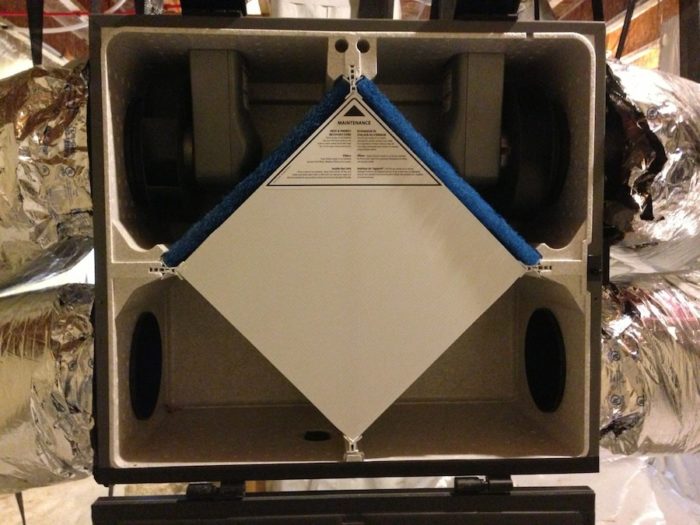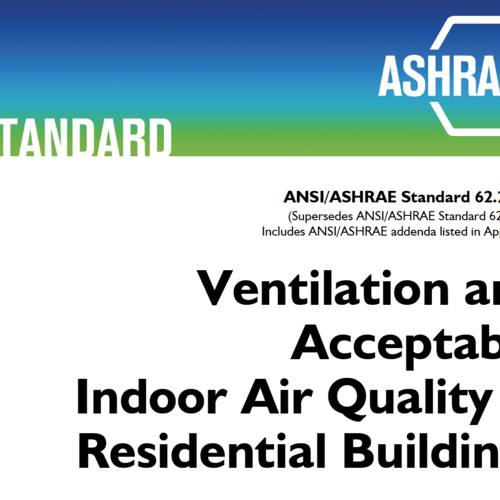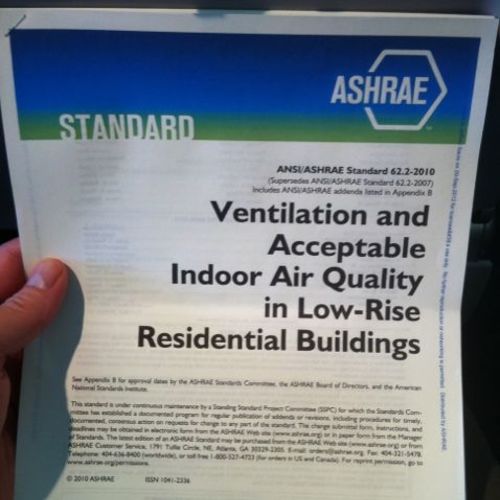
Image Credit: Energy Vanguard
“ASHRAE 62 is the only national consensus standard document there is. Follow 62.2. Resistance is futile.” So said Dr. Max Sherman last summer in a presentation for the Building America Technical Update meeting. (Download pdf official report here.) That statement about resistance being futile isn’t generally a line you want pinned to you if you’re trying to win hearts and minds, but I asked Sherman about it. There’s a whole lot more to the story, too, so read on.
“Resistance is futile.” Martin Holladay dug up this quote for his article on the battle over residential ventilation recently. When I asked Sherman about it, he told me that he used it to “indicate that rather than try to make 62.2 go away it was better to work the ASHRAE process to propose improvements.”
At first, I thought his saying that “Resistance is futile” was quite illuminating†, perhaps putting him in league with the Borg. I wasn’t at the meeting, however; according to Sherman, “The tone was light and bantering not overbearing or borgish.”
The stage is set
The details about the residential ventilation battle have been covered extensively here and at Green Building Advisor several times already this year (see my list of related articles below), including in Martin Holladay’s recent article, How Much Fresh Air Does Your Home Need?
Martin’s article has dozens of comments, including at least 9 from people at the highest levels of the battle (Joe Lstiburek, Paul Francisco, and Paul Raymer). And of course, you should read Joe’s article, Unintended Consequences Suck, for his take on how ASHRAE has gone off-course with the 62.2 standard.
To recap, ASHRAE 62.2 is the residential ventilation standard used by some programs and building/energy codes. It uses either a formula or a table to determine the amount of mechanical ventilation needed in low-rise residential buildings. The 2010 version automatically included an infiltration credit of 2 cfm per 100 square feet of conditioned floor area. The 2013 version took out the infiltration credit, and only made the credit available to homes that can prove that they are leaky enough to deserve it. Thus, the 2013 version yields higher ventilation rates than the 2010 version.
Many people already thought the 2010 version called for ventilation rates that were too high. In hot humid climates, more ventilation means more moisture that must be dealt with. In cold climates, more ventilation means more heating.
Here’s a quick look at the required rates in the last two versions of 62.2. A three-bedroom, 2,500-square-foot house would need 55 cfm according to 62.2-2010. The same house would need 105 cfm in the 62.2-2013 version.
In addition, Joe Lstiburek has argued that a blower door can’t tell you how much ventilation you need in a house. “Fact is that you don’t know where the holes are with a blower door test. You don’t know the pressures across those holes. You don’t know the nature of the holes,” wrote Joe in a comment addressed to Michael Blasnik in that article.
Lstiburek also pointed out in another comment that we don’t have research data relating blower door results, ventilation rates, and indoor air quality. “No epi studies were done… This has all been guess work. No health studies exist. No baselines have ever been measured.” Without data, he says, any ventilation rates we propose are mere guesses.
Suffice it to say that the battle has been heated. Max Sherman and Joseph Lstiburek, both with PhDs and heavy credentials in the world of building science, have been on opposite sides of the issue for years. Now, the battle is about to enter a new phase.
Enter Building Science Corporation’s new ventilation standard
Sherman may be correct about ASHRAE 62.2 being the “only national consensus standard document there is,” but that doesn’t mean that resistance is futile. Joe Lstiburek and Building Science Corporation (BSC) are about to release their own residential ventilation standard. That’s right. We’re about to have competing standards in the marketplace.
Here’s a quick overview of the features in BSC’s new ventilation standard, which is still in draft form:
- It’s for new, code-compliant homes only.
- The formula is similar but yields lower ventilation rates than ASHRAE 62.2-2013.
- The rate gets modified by 3 parameters: balance, distribution, and mixing.
- There’s no infiltration credit.
- There’s no adjustment in ventilation rates for different climate zones.
- There’s no provision for ventilation based on sensors of CO2, relative humidity, or any other indoor air components.
- It has other requirements similar to 62.2 (intermittent ventilation, local exhaust, garage separation, filtration…)
New homes. Having the standard apply only to new homes throws the infiltration credit out the window and leaves existing homes on their own regarding the need for mechanical ventilation. That makes it easier to have a good standard because it isn’t trying to do too many things.
Ventilation rates. Here’s the main formula in the draft BSC standard:
Qv = 0.01 Afloor + 7.5 (Nbr + 1)
To say it in words, the ventilation required (Qv) is 1 cfm for each 100 square feet of conditioned floor area (Afloor) plus 7.5 cfm per person. The number of people is defined as the number of bedrooms (Nbr) plus 1.
This formula is identical to the formula for 62.2-2010. It’s lower than 62.2-2013 because that standard requires:
Qv = 0.03 Afloor + 7.5 (Nbr + 1)
Now that’s not the final result for the BSC ventilation rate because you have to factor in what type of ventilation system is being installed. If it’s a balanced system and the air is distributed, you use the number straight from the formula. If it’s balanced but not distributed (defined as delivering ventilation air to the common area and each bedroom), multiply by 1.25. If it’s not balanced but distributed, you multiply by 1.25. If it’s neither balanced nor distributed, you multiply by 1.5. The table below, from the BSC standard, shows how it works.
Note also that in addition to balance and distribution, mixing of the air in the home can affect the ventilation rate. If the home has all three — balanced and distributed ventilation with air-mixing — it knocks the required ventilation rate down by 25%. The result of all this is that a three-bedroom, 2,500-square-foot home, which would need 55 cfm to meet 62.2-2010 and 105 cfm to meet 62.2-2013, would need anywhere from 41 cfm to 83 cfm under the BSC standard.
Infiltration credit. This has been one of the thorniest issues in 62.2. It’s basically there because of weatherization programs that air-seal existing homes and need to know at what airtightness should they add a mechanical ventilation system. As I mentioned above, Lstiburek disagrees with the premise that a blower door can tell you how much ventilation a home needs. They sidestep the whole issue of existing homes, though, by making a standard for new homes only.
In 62.2, the infiltration credit applies to both new and existing homes. The committee has decided that air leaking into the house through random holes in the building enclosure can qualify as ventilation air. Even though that standard is titled “Ventilation and Acceptable Indoor Air Quality in Low-Rise Residential Buildings,” there’s no IAQ justification for allowing infiltration to count as ventilation. The infiltrating air could be coming from the garage or the attic or the vented crawl space. Air from those places generally makes indoor air quality worse, not better.
Climate zones and sensors. The new BSC standard includes no provisions for adjustments based on climate zones. According to Lstiburek, you can make a convincing argument that cold climates need more ventilation, but you also can make a convincing argument that hot, humid climates need more ventilation. In the end, he says, it’s best to have a one-size-fits-all standard and leave the variations to the occupants.
On the topic of CO2 or relative humidity sensors controlling the ventilation systems, Joe wrote a while back, “CO2 and humidity are not good proxies for good air quality. They are better than nothing. But not much better.” So the BSC standard has no provisions for changing the ventilation rate based on those factors.
Kitchen and bath exhaust fan. One difference between ASHRAE and BSC is that the kitchen and bathrooms must have occupant-controlled exhaust fans, not continuously operating exhaust fans. Unlike 62.2, the BSC standard does not allow continuous fan operation at a lower rate. “Get the stuff out quickly and effectively. Then turn these fans off,” Joe said.
Ventilation quality gets recognized
One of the most important aspects of this new standard is that it recognizes that not all ventilation systems are created equal. Exhaust-only ventilation relies entirely on random leaks in the building enclosure. Supply-only systems have numerous problems themselves. Balanced systems are the best, but they’re more expensive.
ASHRAE 62.2 pays no heed to how well a system ventilates, however. Its main focus is on ventilation rates, which Lstiburek contends are not based on solid science. The new BSC standard “penalizes poor systems and rewards good systems,” Joe said. If the system “sucks and blows,” you can use a lower rate. If it sends the ventilation air throughout the house, you can use a lower rate. If the air in the house gets mixed well, you can use a lower rate.
The launch of BSC-01
As I mentioned above, this standard is still in draft form and hasn’t been released yet. Some details may change before the final release, but the bones of it are mostly in place now. The official launch of Building Science Corporation’s first standard, BSC-01, is set for early August, during the Westford Symposium on Building Science (affectionately known as Building Science Summer Camp, the official meeting of the Building Science “Illuminati†“).
Standards, codes, and programs
Standards are recommendations only. A lot of organizations make standards. Sometimes different organizations make competing standards. Take the case of BPI’s existing home energy audit standard and the flack they’ve gotten from ACCA, ICC, AHRI, and 10 other organizations. What matters is which standard gets adopted by building codes and programs.
Currently, ASHRAE 62.2 is used in several places, mainly because it’s been the only show in town. It’s deeply embedded in the Energy Star Homes program, with many requirements therein taken straight from 62.2-2010.
Game on
As with the competition for adoption between BPI’s and ACCA’s energy audit standards, soon BSC will be giving ASHRAE some competition for residential ventilation standards. You can read a lot of the details of the debate between Max Sherman and Joe Lstiburek in Martin Holladay’s article, but so far it’s all been over what should and should not be included in ASHRAE 62.2.
With a competing standard soon to appear in the marketplace, organizations looking for guidance will have alternatives beyond just adopting 62.2 or not. Joe is confident that his new standard will get adopted in more places than 62.2. As Joe told me recently, “In the marketplace of ideas, better ideas will win.”
In fact, I think he’s really looking forward to the battle. His response to Max Sherman’s statement that “resistance is futile” is, “Game on.”
Footnote
†In an ongoing discussion on ventilation in the Building Science Community group on LinkedIn, Sherman has taken to calling unspecified opponents of his ideas the “illuminati.” For example, he wrote that “the kind of sub-standard system certain illuminati argue for would be fine” if controlling odors were the only necessity.
Allison Bailes of Decatur, Georgia, is a speaker, writer, energy consultant, RESNET-certified trainer, and the author of the Energy Vanguard Blog. You can follow him on Twitter at @EnergyVanguard.
Weekly Newsletter
Get building science and energy efficiency advice, plus special offers, in your inbox.















10 Comments
Where's the Science?
Let's be clear, both of these standards are SWAGs.
The BSC standard will incorporate their vast experience and common sense, which is good enough for me. It also puts some of the responsibility for air quality on the occupants, a good thing in this case.
What would "the science" look like?
I agree with Kevin, the thing I kept looking for in the BSC piece is: what science needs to be done? Is it understanding pollutants, their production within the building, and their effects at different concentrations? I'm not for a second saying that it's simple, far from it, but laying out an agenda that can be taken to appropriate science funding agencies would be a great contribution. Much better than fighting guesses with different guesses.
Think 2020
All parties involved -- even the ASHRAE 62.2 standard members that disagree with BSC are well qualified and have a vast experience. But they also have very different views of what the as built and future built residential homes should look like (HVAC/energy view point).
I do not believe either group advocates solving a air quality problems ONLY with simple exhaust fans, and currently addressing the "bad" pollutants really means controlling the pollutants at the source or DILUTING them with fresh air. So the question then becomes what are the allowable levels of pollutants in the residence and how fast can you dilute the bad stuff to that allowable level.
While, I like the BSC proposal better - I still have heart burn with the lack of a provision for demand controlled ventilation (DCV) in a house. We do have low cost sensor technology available now -- for VOC's and not just CO2, but without including allowable levels and provisions for demand ventilation, no manufacturer or builder will risk their time and money.
I would like to see at least one of the proposed guidelines include a path that includes DCV. It does not need to be 100% modulated by the sensors -- it could simply allow the ventilation rate to drop 50% of their calculated rates while the VOC,CO2,CO, and O3 remain at or below allowable levels (Or step down the NBR value to 1 - while levels are acceptable). When the levels are exceeded the ventilation is then increased and modulated to "dilute" the air at a much higher rate -- perhaps 150% the existing 62.2-2013 standard.
One of the arguments against DCV is that without hard standards for residential the pollutants - the air quality is subjective. I agree - however - I am also reminded by my kids (now adults with their own homes) that I like a colder house and they prefer warmer homes. Manufacturers are addressing the variability of home owners by creating smarter thermostats.
NEST and other manufacturers are now offering thermostats that "learn" the thermal preferences of the house hold members. If it's to cold you raise the temp, it it is too hot you lower it. The thermostat knows the time, knows the outdoor conditions and it learns (via cloud based programs) what the optimal settings for the house are and it then follows that program in the future... you change the temperature and it keeps learning.
We could be doing the same with ventilation - set a minimum standard to ensure that the cats and dogs don't die, keep the flow down so house does get fresh air. Sense the air quality, learn the indoor environment and if the residents push the "stuffy" button - make adjustments. Move away from a "single" sensor measurement point and include multiple sensors in the house - by 2020 the wireless sensor motes -- with temp, RH, VOC, CO2, CO, and O3 could be selling for $35-50 (2013 dollars equivalent).
Sensors can easily monitor the VOC's, CO2, CO and O3, if they approach the limits -- instead of squawking "Fire Fire FIre" like some of the audible smoke detectors, if the future the HVAC thermostat/controller could be hollering "Ventilate, Ventilate, Ventilate...."
Any guideline or standard written in 2013 needs to help further push the residential HVAC systems to where we need them in 2020.... don't prevent DCV, just place higher expectations on the allowed DCV systems...
Offer a path to a more energy efficient home and one that the EPA will view positively -- and the energy star programs will adopt this new path as a standard and move away from standards that burn through the coal just to keep the air fresh...
Comparisons
I decided to do a quick spreadsheet for three homes I'm designing right now with the three methods for ventilation based on your article: 2010 ASHRAE 62.2, 2013 ASHRAE 62.2 and BSC-01. What I can tell, based on my PhD obtained at the Okie State bars, is that smaller houses have proportionally higher ventilation per square feet, and if you were to assume that larger homes have much higher volume, so does it make sense that the larger homes have even less ventilation per house cubic foot of air? One would think that the amount of air to be exchanged is also directly proportional to the volume of air to be exchanged some how! Also, does the length of time that a supply only or balance ventilation system runs should be a consideration for the total amount of cfm that needs to be supplied? Attached is my R&D...
what Dennis sez
Okay, so if CO2 and humidity aren't good mechanically-measureable
metrics of the interior "pollution" level, what are??
What will the ventilation recommendation wind up being for times
when a thermally-stable building doesn't need cooling, but the
outside air is nasty and humid? Are we going to mandate bringing
in an undesirable quantity of that yuck without necessarily
having an opportunity to pre-treat it? If it's already drier
indoors, my preferred ventilation rate in that scenario would
be the absolute bare minimum to avoid asphyxiation, down to and
including zero if necessary, until ambient conditions improve.
_H*
VOC's and othes
It takes a lot of CO2 to get you sick... well over 3000 ppm for extended times. Outside background is now running about 400 ppm, in homes it probably sits at 600-1200 ppm with living bodies. In the past CO2 has been used as an indicator of bad air quality -- using it as a proxy for other chemicals that were harder to measure. These included : Benzene, Formaldehyde, Napthalenes, NOx. Carbon Monoxide.
EPA, World Health Organization, many universities have lots of published papers with numbers. The problem is there are soooo... many numbers and possible bad stuff it's hard to decide what to check.
In the last ten years many sensors for bad stuff have been made lower cost and are readily available. Carbon Monoxide (CO) is a good example. Every home should have multiple CO detectors - and the prices have come down because of the wide spread requirement and adoption. The CO sensors are very similar to Benzene, Methane, Alcohol, Napthalene sensors. These are generally a metal oxide on a substrate that is heated slightly -- the reaction to the bad chemical changes the metal oxide resistance and it can be detected. Early on the sensors did not have a great life - but as seen with CO detectors those problems can be solved. In singles quantities, individual Benzene, Methane, Napthalene sensors are currently running around $5 each. NOx sensors are slightly higher. For some of the other bad stuff the technology used is based on fuel cells. The Formaldehyde (HCHO) sensors are often fuel cells that are tuned.
CO2 sensors are dropping in price - there is good competition in the technologies. In prior years the only real choice for a stable CO2 sensor was NDIR (non dispersive IR -- CO2 gas absorption). But that has changed -- more competition, more vendors, and the new tuned metal oxide sensors. The automobile industry is using CO2 sensors in their products - that has lowered the price -- a lot! The result is that semiconductor companies like Texas Instruments are now offering chips that are designed to make the use of sensors easy.
In the last couple of years - I've seen significant work on fusion of better optical sensors to detect the bad stuff with specially designed chemical sensitive optical plates. Think of a piece of glass that changes shades in the presence of HCHO and can be reset with UV light. But now the UV light is from a UV-LED and the package looks like a little matchbox.
Formaldehyde sensors are still pricy (DART's) is still nearly $100 when you add in the support electronics -- BUT it is fuel cell based and NEW. A metal oxide sensor that also responds to HCHO and benzene - can be found for about $20 in single units.
Reliability questions are always asked - and the answer is the new sensors fail at about the same rate as the CO detectors (with good batteries). You can address the reliability issue by requiring a DCV based ventilation system have a sensor mote in each bedroom, family room and major living space. The sensor motes report back to the common thermostat (perhaps a NEST like device) that then sets the ventilation rate. If bad stuff is "sniffed' in any room the rate goes up. If CO is detected you raise the exchange rate as high as you can go... 200% if possible. If NOx is detected - it can be a result of cooking or back drafting by a combustion zone appliance -- some communication with the mega-RANGE-hood may be required. But the it would also be able to set off alarms and crank up the ventilation.
Most of this stuff is the future - five or six years out. But standards take a few years to adopt, no new residential DCV HVAC products and controls will be created if a standard does not allow for them. Think 2020!
Attached is an example of VOC detection from simple under arm deodorant... the sensors is a cheap USB stick with simple software that can be bought for about $30 -- in singles. In thousands the sensor goes for under a couple of dollars...
now you are talking sense
Rather than blindly ventilating away all the envelope and efficiency gains of the past 3 decades.
Some back of envelope calculations:
I live, quite happily with 4 other members of my family, in a 3 ACH 50 3400 SF home. Using an ACH50 vs ACHnat divisor of 20, we perhaps get right at the right amount of outside air for the home and 5 occupants per ASHRAE 62.2-2010, about 60-70 CFM.
Despite a dearth of mechanical ventilation, we are healthy - all five of us average less than one sick day from work or school per year.
I'm annoyed by the complete removal of infiltration credit. While it certainly does vary, all homes, particularly multistory and beachfront homes have some natural, wind or stack driven, ventilation going nearly all the time.
If we are forced to move ahead with this, I hope we are given the option to bypass continual ventilation and use demand driven, and that CO2 sensors are the right animal. I hear about that both ways - CO2 seems to be allowed for commercial, OTOH some commentators, including Joe, insist CO2 is a poor indicator of IAQ, since it ignores a zillion other potential contaminants.
I do know that if we are forced to always provide 50-100 CFM outdoor air into a typical midsized house, 24/7 regardless of occupancy, etc, we are going to be taking a step back on both energy conservation and humidity control. Given how committees make rules in a manner like Congress, I'm forced to wonder if the central dehu or ERV lobbies have an unseen hand in these standards.
If I brought 50 CFM outside air into this house from sundown to sunrise, after the sun load is gone, I will have in 11 hours replaced the conditioned air (all 34,000 CuFt of it at 45% RH), with outdoor air at about 90% RH, all summer and I won't be very happy. That works out to almost 3 gallons extra water in house air, and 2.25 ton heat pump (mine in low gear) operating at 75% sensible heat ratio (industry standard) would take almost 3.5 hours to yank that amount of water out of house air. That ignores latent load already in house (infiltration, respiration, evaporation). Experience suggests we hold 45% RH through the night with about 2 hours heat pump operation through the night, a happy circumstance caused by slow leakage of the previous day's solar gain through our ICF walls all night.
If 3.5 additional hours HVAC operation is needed to unload the moisture occasioned by an all night forced minimum 50 CFM outdoor rate, normal ride-along dehu won't catch back up until well past noon on a typical day.
The best available (i.e. most energy efficient) central dehu would cost $2500-3000 to install and require 4-6 kwh to yank the 3 extra gallons water out of the air in a more timely manner. It would load the heat pump with another 1-2 ton-hours of sensible load in addition, costing yet another 1-2 kwh. Stated another way, compliance with a requirement for just 50 CFM continuous outside air would increase my HVAC cost by 50+% much of the year.
An ERV might somewhat combat the extra operating cost, albeit at yet higher capital cost. An ERV does NOT displace a central dehu, merely shifts some load from it.
This "solution" seems to be in search of a problem to solve...unless the "problem" is low sales of pricey ERVs and central dehus!
Nuts... Iaq.... My grandma
Nuts... Iaq.... My grandma lived to 99 on standard grocery store non organic food and in a coal fired home with no ac and no dehumidifiers and no sensors.
Good luck... All... No matter what ya do... You die.
Give up and just enjoy.
They don't make Grandmas
They sure don't make Grandmas like they used to!
Log in or create an account to post a comment.
Sign up Log in